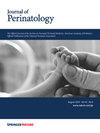Drivers of care and outcomes for people facing fetal conditions in the United States: a conceptual framework
IF 2.4
3区 医学
Q2 OBSTETRICS & GYNECOLOGY
引用次数: 0
Abstract
Congenital anomalies, affecting 3–5% of pregnancies annually in the United States, are a leading cause of fetal and infant mortality. Despite advancements in fetal care, disparities in care access, quality, and outcomes persist and remain poorly understood. This perspective introduces the Fetal Condition Care and Outcomes (FCCO) Framework, a conceptual model that integrates contextual, individual, structural, and process-level factors influencing care and outcomes. We build on prior adaptations of Andersen’s Behavioral Model of Health Service Use and the Donabedian Structure, Process, and Outcomes Model, expanding their application from risk-appropriate neonatal care to individuals’ whose pregnancies are complicated by severe fetal conditions. By synthesizing evidence across disciplines, we highlight critical gaps in understanding the drivers of disparities, including barriers to timely diagnosis, variations in counseling practices, and inequities in access to specialized services. This article calls for interdisciplinary research to ensure risk-appropriate, person-centered care for this high-risk population.

美国面临胎儿状况的人的护理和结果的驱动因素:一个概念框架。
在美国,先天性畸形每年影响3-5%的妊娠,是导致胎儿和婴儿死亡的主要原因。尽管胎儿护理取得了进步,但在护理可及性、质量和结果方面的差异仍然存在,而且仍然知之甚少。这一观点介绍了胎儿状况护理和结果(FCCO)框架,这是一个概念模型,整合了影响护理和结果的环境,个体,结构和过程层面的因素。我们在先前对Andersen的健康服务使用行为模型和Donabedian结构、过程和结果模型的改编基础上,将其应用范围从适合风险的新生儿护理扩展到因严重胎儿状况而复杂化的妊娠个体。通过综合跨学科的证据,我们强调了在理解差异驱动因素方面的关键差距,包括及时诊断的障碍、咨询实践的差异以及获得专业服务的不公平。这篇文章呼吁跨学科的研究,以确保风险适当,以人为本的护理这一高危人群。
本文章由计算机程序翻译,如有差异,请以英文原文为准。
求助全文
约1分钟内获得全文
求助全文
来源期刊

Journal of Perinatology
医学-妇产科学
CiteScore
5.40
自引率
6.90%
发文量
284
审稿时长
3-8 weeks
期刊介绍:
The Journal of Perinatology provides members of the perinatal/neonatal healthcare team with original information pertinent to improving maternal/fetal and neonatal care. We publish peer-reviewed clinical research articles, state-of-the art reviews, comments, quality improvement reports, and letters to the editor. Articles published in the Journal of Perinatology embrace the full scope of the specialty, including clinical, professional, political, administrative and educational aspects. The Journal also explores legal and ethical issues, neonatal technology and product development.
The Journal’s audience includes all those that participate in perinatal/neonatal care, including, but not limited to neonatologists, perinatologists, perinatal epidemiologists, pediatricians and pediatric subspecialists, surgeons, neonatal and perinatal nurses, respiratory therapists, pharmacists, social workers, dieticians, speech and hearing experts, other allied health professionals, as well as subspecialists who participate in patient care including radiologists, laboratory medicine and pathologists.
 求助内容:
求助内容: 应助结果提醒方式:
应助结果提醒方式:


